

Home Grown is a small family-owned company with a love for
gardening. From our own backyard, we have cultivated a passion
for gardening that we want to share. We believe that it should be
accessible to everyone, fun, and easy to start. Our goal at Home
Grown is to .provide you with the best quality products and services.
Our team has spent years sourcing and creating products that help
everyone, from beginner to experienced gardeners alike
No green thumb? No worries!
We made sure that no green thumb is required to help you have your
dream of gardening come true by providing you detailed instructions
and guides which are included in all of our seed packs and kits.
We hope you experience the same joy we have found for
gardening.

If you are looking for a variety of
colorful flowers that can be planted
either in spring or fall, then you’re in
luck! Our flower seed pack contains 10
species of annual flowers, but many of
them will self-seed and return again the
following spring!


Autumn Beauty sunflower is a gorgeous
variety that offers a beautiful mix of warm
colors including orange, bronze, red, and
yellow. Some of the blooms are even
multi-colored. Autumn Beauty sunflower is
believed to have first been harvested for use
by Native American tribes dating back as
far as 2000 B.C. Established Autumn Beauty
sunflowers can tolerate drought but make
sure to regularly water during the flowering
period. Since the plant grows up to 8 feet,
the stems may droop to the weight of the
flowers. Use stakes and twine to support the
plant.
Sowing Indoors
Autumn Beauty sunflower can be started indoors in about 6 to 8
weeks prior to the last frost. Use small pots, trays, or other containers
that are at least 6 inches deep. The seeds should be planted 1/2
inch beneath the surface of the soil. Autumn Beauty sunflower can
be germinated in groups with 3 seeds together or individually. Be
sure to allow several inches of space between each seed or group
of seeds. The soil should be kept moist at all times while taking care
not to overwater the seeds. Keep the planter in a bright place. The
germination process typically takes 10 to 21 days.
Transplanting
When spring has arrived and there is no longer any danger of frost
conditions, Autumn Beauty sunflower seedlings can be safely
planted outdoors. Choose an area of ground with plenty of sunlight.
The seedlings should be planted approximately 12 inches apart. To
allow easier care and harvesting, plant the seedlings in straight rows
with 20 to 24 inches between each row. The soil should be kept moist
but not wet.
Sowing Outdoors
Directly sow outside in spring when the danger of frost conditions
has passed. Select an area that receives ample sunlight throughout
the day. Clean the area from weeds and loosen the soil. Sow the
seeds at the depth of 1/2 to 1 inch. Space the seeds approximately 12
inches apart and keep moist. If planting multiple plants, leave 20 to
24 inches between the rows.
Harvest and Use
Autumn Beauty sunflower will be ready for harvest once the flowers
have died back completely. The back of each flower head should be
brown. Cut the flower head, leaving 5 to 10 inches of stem and hang
to dry. When dried, rub the flower head over the bucket to catch seeds.
Some of the most common uses for Autumn Beauty sunflower include the
production of cooking oil, margarine, broths, salads, cakes, and other desserts.
Sunflower seeds also make a great snack!
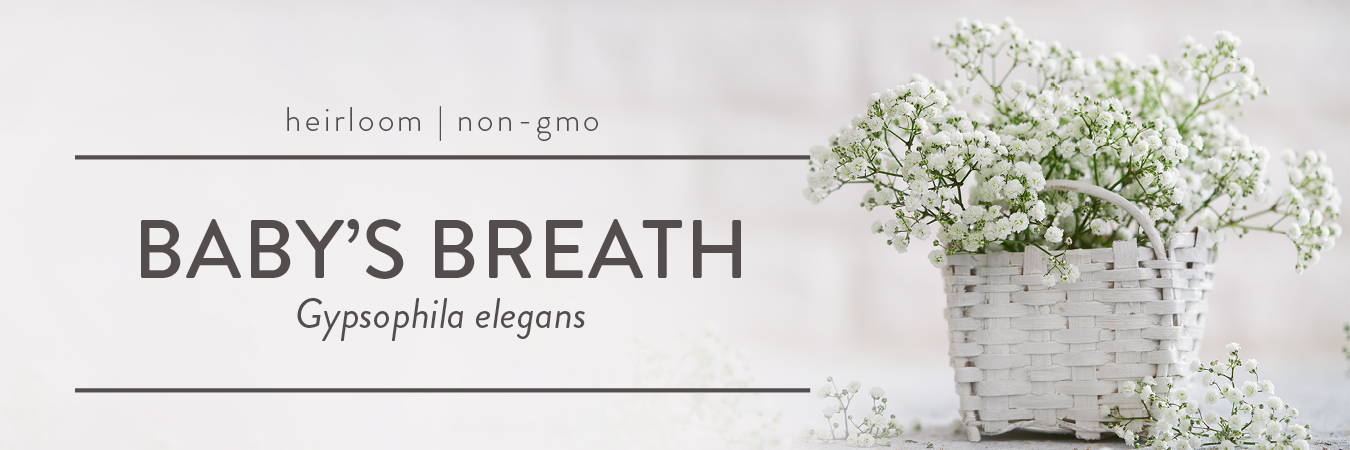
One of the most popular species in the floral
industry, baby’s breath blooms are usually
used as fillers in flower bouquets and are
used in rustic-themed weddings and other
events. But planted in gardens, they can
provide a serene setting with their small
white or pink buds. An ideal choice for a
beginner gardener, this flowering plant is
fast-growing and easy to maintain. As a
bonus, it will bring a number of beneficial
pollinators to your garden!
Sowing Indoors
To get an early start, sow baby’s breath seeds indoors approximately 6 to 8
weeks before the last spring frost. Use a seed starting tray filled with well-
drained soil. Place seeds 1/4 inch deep and keep the soil moist until
germination. Keep the planter with seeds in a warm, bright site. For
best results, ensure that soil temperature is at least 70°F. Under the
right conditions, you will see the first sprouts in about two to three
weeks.
Transplanting
When seedlings sprout 2 pairs of leaves and all danger of frost has
passed, start hardening them off. Do this by bringing the planter
outside for a few hours per day and then gradually increasing their
time outdoors each day until they’re fully adapted to outdoor
growing conditions. Before transplanting to the garden, prepare the
soil bed by removing weeds and loosening the soil. Place the plants 9
inches apart and water generously.
Sowing Outdoors
Start preparing to plant outside when the danger of frost has passed.
Select an area in the garden that receives full sunlight. Prepare the
area by removing weeds and loosening the soil. Sow seeds 1/4 inch
deep and 9 inches apart. Keep the soil moist until germination. You
can sow baby’s breath two times per season as they’re fast growers.
Another option is sowing in the fall for early spring blooms. In this
case, sow the seeds a little deeper than usual.
Care
Remove weeds regularly as these compete with the nutrients baby’s
breath gets from the soil. Water at least once a week or when the
soil is dry. Overwatering may cause root rot, so be careful! For flower
arrangements or for use in bouquets, cut long stems. For longer
display life, select flowers that are not fully opened yet.

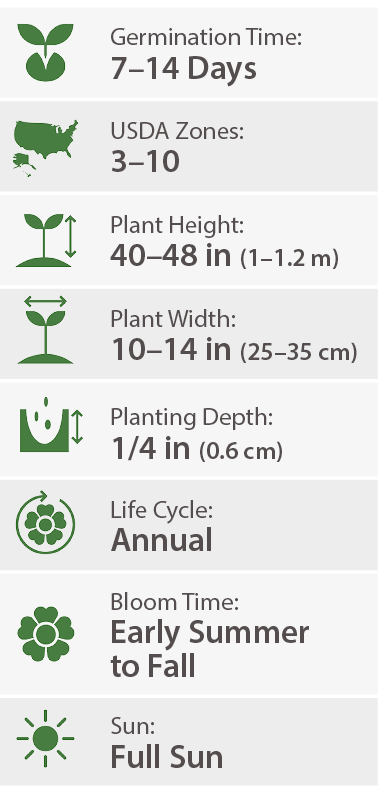
One of the easiest flowers to grow, California
Giant zinnia is a stunning variety that
produces remarkably large blooms in
wonderful shades of yellow, orange, red,
pink, purple, and white. This enormous
annual plant blooms all summer long,
attracting a number of butterfly species.
California Giant zinnia is a tough variety that
withstands drought fairly well and it’s often
used in xeriscaping.
Sowing Indoors
To get an early start, California Giant zinnia can be started indoors—just be sure to
handle the transplants very carefully as they are extremely sensitive.
Start seeds indoors, about 4 to 6 weeks before the last frost date in your area.
Prepare a seed starting tray and fill it with fertile, well-drained soil.
Sow 3 to 4 seeds per cell at the depth of 1/4 inch and water thoroughly, but gently.
Keep the soil constantly moist until germination occurs. The optimal soil
temperature needed for germination is anywhere between 70°F and
80°F.
Transplanting
Transfer the seedlings during spring or when the temperature is at
least 70°F and there’s no longer any risk of frost. Be sure to harden
them off by bringing trays outside for a few hours per day and then
gradually increasing their time outside each day until they can spend
a whole day outdoors. Thin the seedlings to the strongest, and plant
them approximately 12 to 18 inches apart. Do this carefully as they’re
extremely sensitive to transplanting. Water the seedlings thoroughly
and water regularly until established.
Sowing Outdoors
California Giant zinnia is best sown directly into the garden, in fertile,
well-drained soil. Sow seed directly in the spring, once the soil is
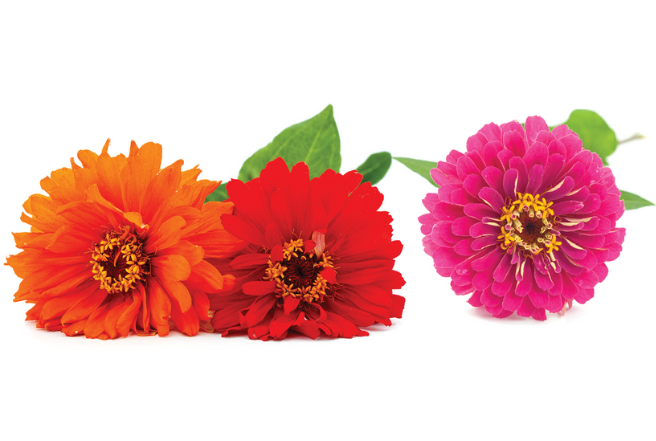
warm enough (at least 70°F) and there’s no longer any risk of frost.
The best time to direct-seed is 1 to 2 weeks after the last spring frost.
Seeds should be planted at the depth of 1/4 inch. When 3 inches tall,
thin the seedlings if they seem too crowded. Water gently. Direct-
seeding in early spring is particularly recommended for warm, frost-
free areas.
Care
California Giant zinnia prefers rich, well-drained soil. It is relatively
drought-tolerant, but you can water the plant during prolonged
periods of drought. Pinch off the stems to promote bushier growth
and deadhead spent flowers to encourage more blooms. Zinnia
makes for a great cut flower; for a longer display, choose blooms that
are not fully opened. Fertilize occasionally.
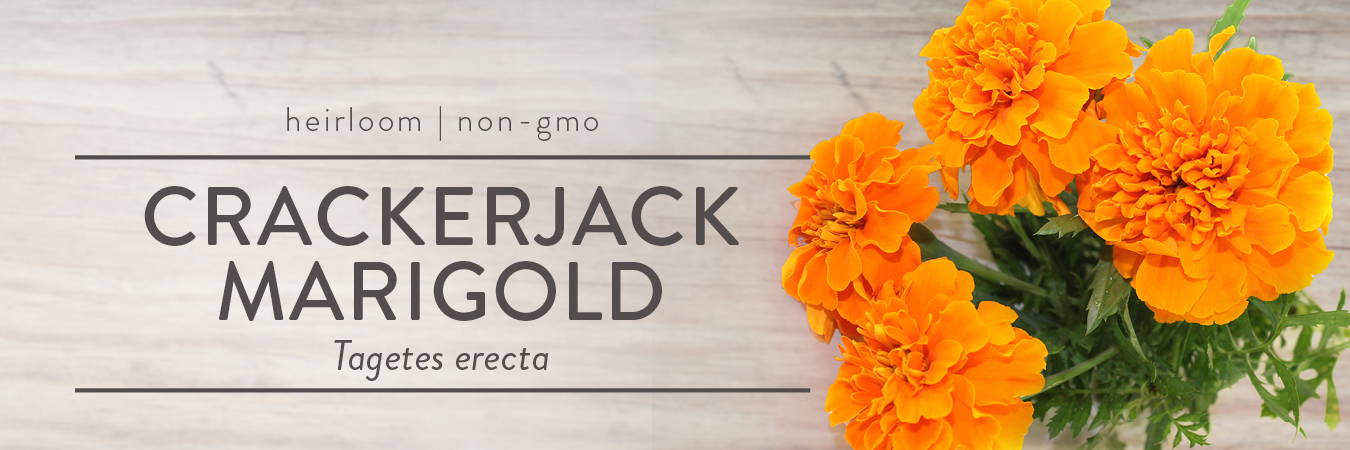
Crackerjack marigold is an heirloom hybrid
variety that boasts impressively large, fully
double flowers that come in several shades
of yellow and orange. A perfect choice for
beds, borders, and path edges, as well as for
container planting. Crackerjack marigolds
are easily grown from seeds and they make
vibrant, long-lasting cut flowers. They
handle heat very well and usually continue
producing blooms throughout the entire
summer.
Sowing Indoors
For an earlier start, sow your Crackerjack marigolds indoors 6 to 8 weeks
prior to the last spring frost date in your zone. Using a seed starting tray filled
with a seed starting soil mix, sow marigold seeds at the depth of 1/4
inch. Sow several seeds per cell, as you will thin your seedlings once
they’re big enough. Keep evenly moist and maintain a steady soil
temperature of around 70°F–75°F. The seeds should germinate in a
week or two.
Transplanting
Once there’s no longer any risk of frost, your marigold seedlings
can be safely moved outdoors. Thin your transplants and leave only
the strongest ones. Prepare a planting site by breaking the soil and
adding garden compost. Plant seedlings 12 to 18 inches apart and
water thoroughly after planting. Water seedlings regularly until
established.
Sowing Outdoors
Crackerjack marigold seeds can be sown directly into the garden. The
best time for direct sowing is early spring in warmer climates or two
weeks after the last spring frost in cooler regions, when the soil has
warmed up to 70°F. Sow 2 to 3 seeds every 12 to 18 inches and cover
with 1/4 inch of soil. Water thoroughly.
Care
Crackerjack marigold seeds can be sown directly into the garden. The
best time for direct sowing is early spring in warmer climates or two
weeks after the last spring frost in cooler regions, when the soil has
warmed up to 70°F. Sow 2 to 3 seeds every 12 to 18 inches and cover
with 1/4 inch of soil. Water thoroughly.
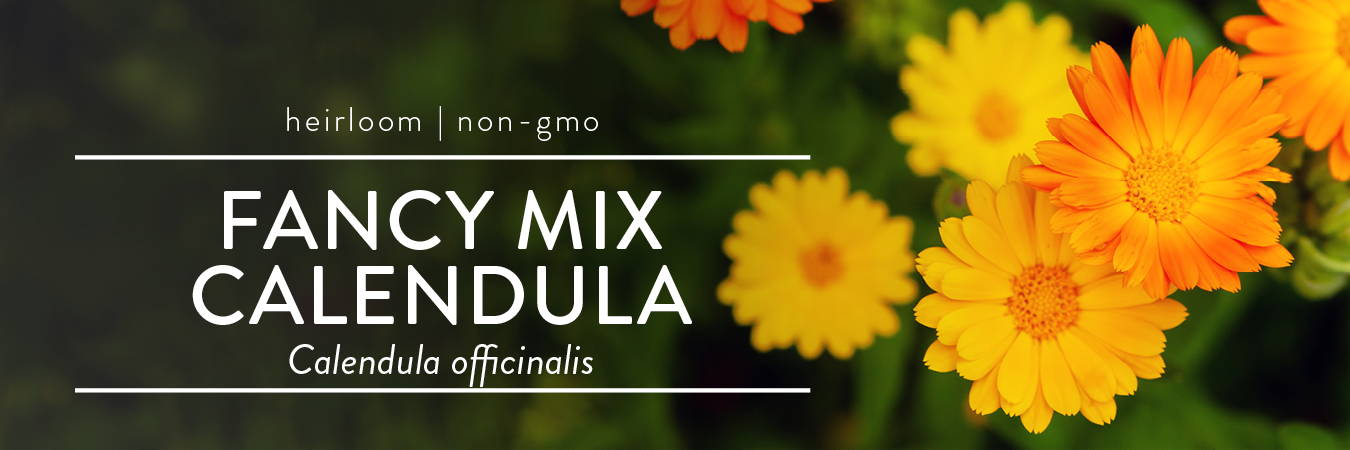
Fancy Mix calendula includes a wonderful
selection of yellow, orange, and orange-red
flowers. Regarded not only for its ornamental
features but also for its medicinal properties,
calendula is appreciated for its numerous
health benefits. As an ornamental, calendula
makes a great choice for beds and borders,
as well as for containers and pots. It is a
natural mosquito-repellent but will attract a
number of beneficial pollinators such as bees
and butterflies. During hot summer days,
your calendula may produce fewer flowers
but will continue at the regular pace as soon
as the growing conditions become favorable
again.
Sowing Indoors
Calendula seeds are best sown directly into the garden, though you
can start them indoors as well. If sowing indoors, start the seeds 6 to
8 weeks before the last spring frost in your area. Use seed starter trays
filled with a seed starting soil mix and sow several seeds per cell. Sow
them at the depth of 1/4 inch. Keep the soil moist and place the tray
in a warm and bright place. The optimal soil temperature needed for
germination is anywhere between 50°F and 65°F.
Transplanting
Once your indoor seedlings are 2 to 3 inches tall and all danger of
frost has passed, you can transplant the seedling outdoors. Thin them
and use only the strongest seedlings. Plant them 12 to 18 inches
apart. Keep the area well-watered until plants become established.
Sowing Outdoors
Direct sowing can be done in spring and fall. In spring, wait until the
soil is warm enough (at least 60°F) and sow the seeds 2 to 3 inches
apart. After a few weeks, thin them to 12 to 18 inches. In fall, sow
the seeds after the first frosts start to hit, but before the soil freezes.
When sown in spring, calendula will bloom in a few weeks, but when
sown in fall, it will bloom the following season.
Harvest and Use
Calendula flowers can be cut for flower arrangements or harvested
for drying. When picking calendula flowers for drying, harvest them
on sunny days, around noon, after the dew has dried. Pick the half-
open flowers as they’re the most potent. Harvest regularly; the more
you harvest, the more flowers each plant will produce. Let flowers dry
in a dark, cool, and well-ventilated place. Once they’re dried, pluck
the petals and store them in a glass jar. Dried calendula flowers make
a wonderful, soothing tea. Flowers and petals can also be used as a
garnish, either fresh or dried.

Heavenly Blue morning glory is an award-
winning cultivar that features large, azure-
blue flowers. Named after its flowers that
open in the morning and close in the
afternoon, morning glories will bloom all
summer long. Thanks to its climbing growth
habit, this vine makes a great choice for
growing against a fence, wall, or trellis.
Resistant to deer, but attractive to butterflies
and hummingbirds, Heavenly Blue is low-
care and virtually pest-free.
For the optimal germination rate, morning glory seeds
require scarification and a short period of stratification. To scarify the seeds,
gently cut the seeds’ coat with a clean knife, but be sure not to damage the interior.
You can also use sandpaper to remove the coating in one small area. Soak
the seeds in warm water for 12 to 24 hours. Seeds that have been
scarified and stratified should be sown as soon as possible.
Sowing Indoors
Start your seeds indoors approximately 4 to 6 weeks before the last
expected frost in your area. Use a large container or a seed starting
tray and sow the seeds at the depth of 1/4 inch, spacing them 2 to 3
inches apart. Water the soil gently and keep the substrate constantly
moist. The seeds will germinate when the soil temperature ranges
between 65°F and 80°F.
Transplanting
Once your seedlings are 2 to 3 inches tall, they are ready to be
transplanted outside. Be sure that all danger of frost has passed,
otherwise, your seedlings may become damaged. Find a full-sun
position for your morning glory seedlings and install some kind of
support (trellis, lattice, fence, or pergola). When planting multiple
plants, space them 1 to 2 feet apart. Water the seedlings thoroughly
after planting and water regularly until established.
Sowing Outdoors
Morning glory seeds can be direct-sown in spring, when the soil
has warmed to approximately 65°F or 2 weeks after the last frost in
your area. As mentioned above, prior to sowing, install some kind of
support. Sow the seeds every 6 to 12 inches and water thoroughly.
When the seedlings are 2 to 3 inches tall, thin them to 1 to 2 feet
apart.
Care
Heavenly Blue morning glory prefers moderately fertile, but well-
drained soil. It has moderate watering requirements but will benefit
from extra water during hot spells or prolonged periods of drought.
Regularly remove the spent flowers to promote more blooms.
Removing the flowers will also prevent the plant from reseeding.
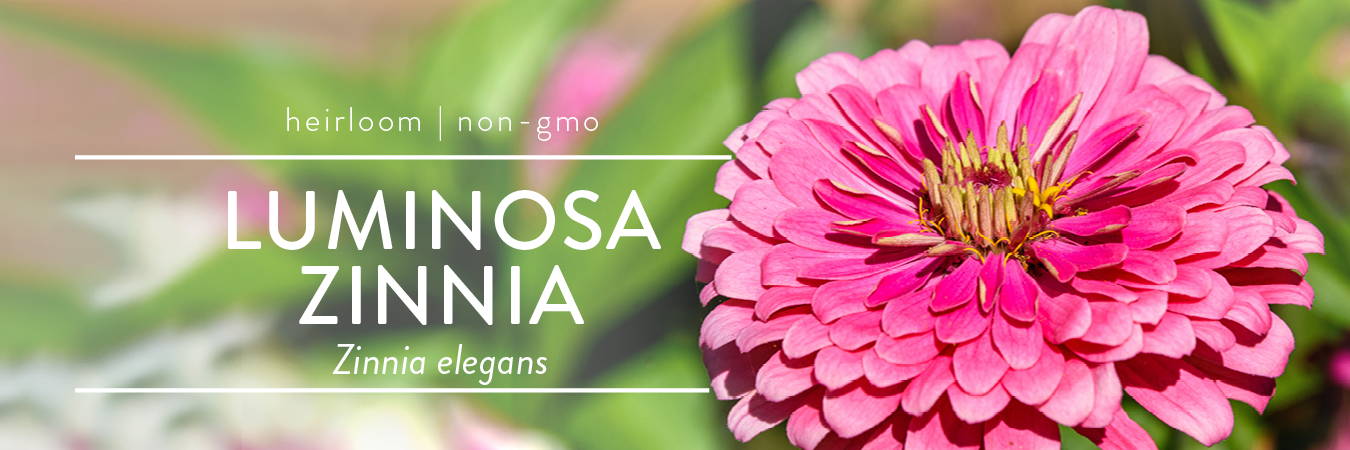
Luminosa zinnia is an amazing variety that
will add bright pink colors to your garden
with its remarkable large blooms. Spring is
the perfect time to plant Luminosa zinnia to
see the gorgeous blooms all summer long.
This low-care plant is fairly drought-tolerant
but will bloom better with regular watering.
With its wonderful blooms, it attracts a
number of beneficial pollinators.
Sowing Indoors
Luminosa zinnia can be started indoors— just be sure to handle
the transplants very carefully as they are extremely sensitive.
When starting indoors, prepare a seed starting tray and fill it with well-drained soil
4 to 6 weeks before the last frost date in your area. Sow 3 to 4 seeds per cell and keep
moist until germination. The optimal soil temperature needed for
germination is anywhere between 70°F and 80°F.
Transplanting
When it is warm enough outside or after the last spring frost, transfer
the seedlings from the seed starting tray outside. Be sure to harden
them off by bringing trays outside for a few hours per day and
then gradually increasing their time outside each day until they’re
fully adapted to outdoor growing conditions. Pick the strongest
seedlings and plant them in an area that receives full sunlight. Plant
the seedlings 12 to 24 inches apart and water regularly until the
stems are strong and upright. Do this carefully as zinnia seedlings are
extremely sensitive to transplanting. Water the seedlings thoroughly
and water regularly until established.
Sowing Outdoors
To start zinnias outdoors, sow the seeds directly into the garden
when the soil has warmed up to at least 70°F. This usually happens
1 to 2 weeks after the last spring frost. Sow them 1/4 inch deep 6 inches apart.
Water thoroughly. When 3 inches tall, thin to 12 to 24
inches. Direct-seeding in early spring is particularly recommended in
warm, frost-free areas.
Care
Luminosa zinnia prefers rich, well-drained soil. It is relatively drought-
tolerant, but you can water the plant during prolonged periods
of drought. Pinch off the stems to promote bushier growth and
deadhead spent flowers to encourage more blooms. Zinnia makes
for a great cut flower; for a longer display, choose blooms that are not
fully opened. Fertilize occasionally.

Polka Dot bachelor’s button is an old-
fashioned cultivar that literally adds a splash
of colors to your garden as it produces lovely
blue, purple, pink, and white flowers. Planted
during spring or fall, this hardy annual
plant blooms prolifically late into summer,
attracting pollinators such as butterflies
and bees. This low-maintenance annual is a
perfect choice for bed and borders, as well
as for cutting, but it’s also renowned for its
edible flowers. Removing spent flowers will
promote even more blooms. Despite its
charming look, bachelor’s button is invasive
in some US states, so be sure to check
whether it’s permitted in your area.
Sowing Indoors
Polka Dot bachelor’s button seedlings do not respond well to
transplanting so starting indoors is usually not advised.
Sowing Outdoors
In cool climates, Polka Dot bachelor’s button should be sown directly
in spring as soon as the soil can be worked. Find a part of your
garden that receives full sunlight. Plant the seeds 1/8 inch deep 6 to
8 inches apart. Water thoroughly, but gently, and keep well-watered
until established. Being a self-seeding variety, once planted, it will
come back each spring.
Bachelor’s button can be sown directly in fall. The seeds will
germinate the following spring. In mild winter areas, bachelor’s
button is best sown in fall.
Harvest and Use
Polka Dot bachelor’s buttons are perfect for fresh and dried flower
bouquets and arrangements. The flower petals are edible—they have
a peppery taste with cloves undertone. Use as a garnish for salads,
cheese plates, and desserts. These can also be used in brewing tea.
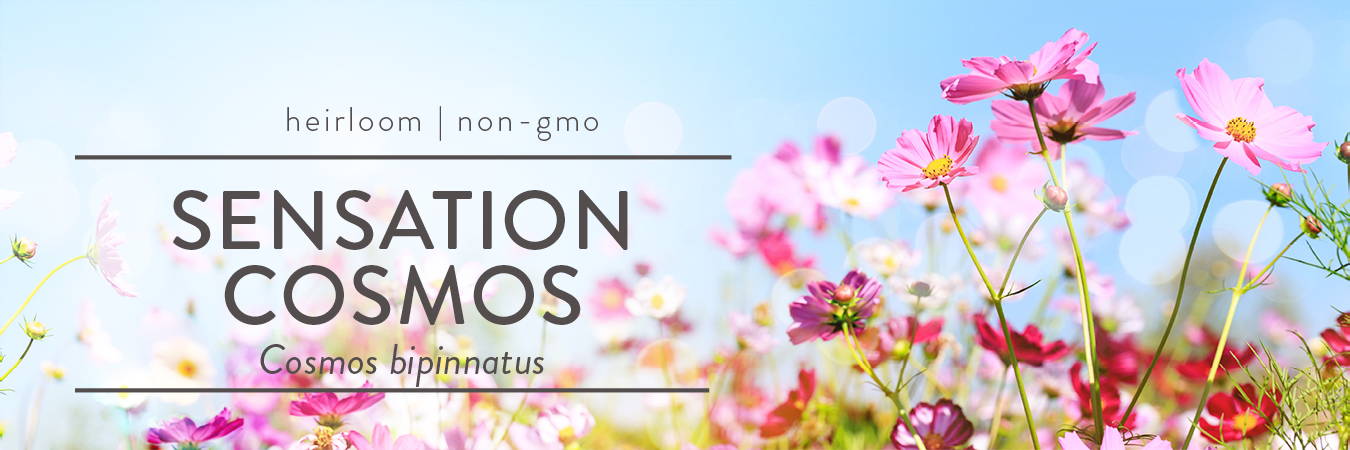
Sensation cosmos produces masses of
tall, daisy-like flowers that come in several
shades of white, pink, and crimson. These
large, 3–4 inches blossoms attract butterflies
and make for wonderful cut flowers. They
will bloom way into the fall until the first
frosts hit. Thanks to their ability to self-seed,
the flowers will come back next spring. An
extremely drought-tolerant plant, cosmos
will give you an abundance of blooms
without much care.
Sowing Indoors
To get an early start, you can start cosmos seeds indoors,
6 to 8 weeks before the last spring frost date in your area. Using a container or a
seed starting tray, sow the seeds at the depth of 1/4 inch, spacing them 2 to 3
inches apart. The soil should be constantly damp, but not overly
wet. Keep the planter in a warm place that receives a lot of indirect
light. When the soil temperature is around 64°F–77°F, the seeds will
probably germinate in less than 10 days.
Transplanting
When all danger of frost has passed and your seedlings are 2 to
3 inches tall, harden them off before transplanting them into the
garden. Bring them outside for just a couple of hours per day and
then gradually increase their time outside each day until they can
spend a whole day outdoors. This way, your seedlings will acclimatize
to the outdoor growing conditions such as hot sun and wind.
When your seedlings are adapted to the outdoor environment,
transplant them into their permanent garden place by spacing them
approximately 18 inches apart. Water the seedlings regularly until
they become established.
Sowing Outdoors
Direct-seed in spring around the last frost, or in the fall after the first
killing frost. Scatter the seeds over the area and cover them with
a thin layer of soil. Keep the area moist. When seedlings are 2 to 3
inches tall, thin if they seem too crowded. When sown in spring,
cosmos will bloom within a few weeks, but when sown in the fall, it
will bloom the following season.
Care
Cosmos is an extremely low-care plant that can withstand drought
very well. Water only if you notice that plants are starting to wilt. Cut
the blooms to promote bushier growth and more flowers. If you’d like
to prevent cosmos from reseeding, remove the flowers before they
go to seed.
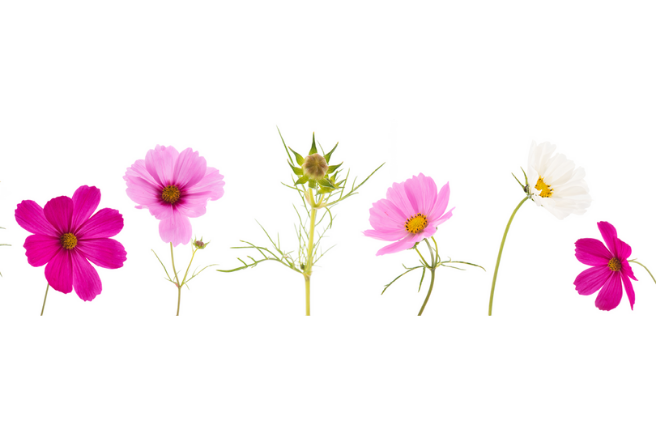
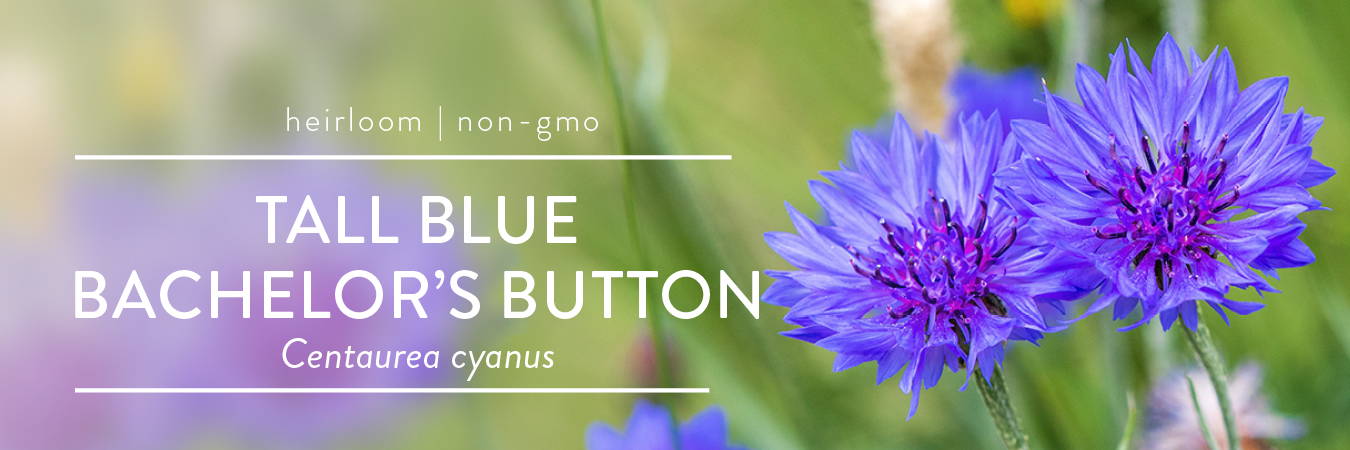
Tall Blue is a classic bachelor’s button cultivar
that produces brilliant blue flowers with
purple hues in the center. True to its name,
this fantastic cultivar grows tall at a height
of up to 36 inches or around 3 feet. A great
choice for beginners, this easy-to-grow
cultivar produces blooms all summer long.
When regularly harvested, it will produce
even more blooms. Great for bed and
borders, as well as for cutting, this flower is
also noted for its edible petals. Despite its
charming look, bachelor’s button is invasive
in some US states, so be sure to check
whether it’s permitted in your area.
Sowing Indoors
Tall Blue bachelor’s button seedlings do not respond well to
transplanting so starting indoors is usually not advised.
Showing Outdoors
In cool climates, Tall Blue bachelor’s button should be sown directly
into the garden once as soon as the soil can be worked. Start sowing
outdoors when the soil temperature is at least 70°F. Find a part of
your garden that receives full sunlight. Prepare the garden bed by
loosening the soil and removing weeds. Plant the seeds 1/8 inch
deep 6 to 8 inches apart. Water thoroughly, but gently, and keep
well-watered until established. Being a self-seeding variety, once
planted, it will come back each spring.
Bachelor’s button can be sown directly in fall. The seeds will
germinate the following spring. In mild winter areas, bachelor’s
button is best sown in fall.
Sowing Outdoors
Direct-seed in spring around the last frost, or in the fall after the first
killing frost. Scatter the seeds over the area and cover them with
a thin layer of soil. Keep the area moist. When seedlings are 2 to 3
inches tall, thin if they seem too crowded. When sown in spring,
cosmos will bloom within a few weeks, but when sown in the fall, it
will bloom the following season.
Harvest and Use
Tall Blue bachelor’s buttons make a great cut flower
for fresh and dried flower bouquets and flower
arrangements. The flower petals are edible—they have
a peppery taste with cloves undertone. Use as a garnish
for salads, cheese plates, and desserts. These can also be
used in brewing tea.